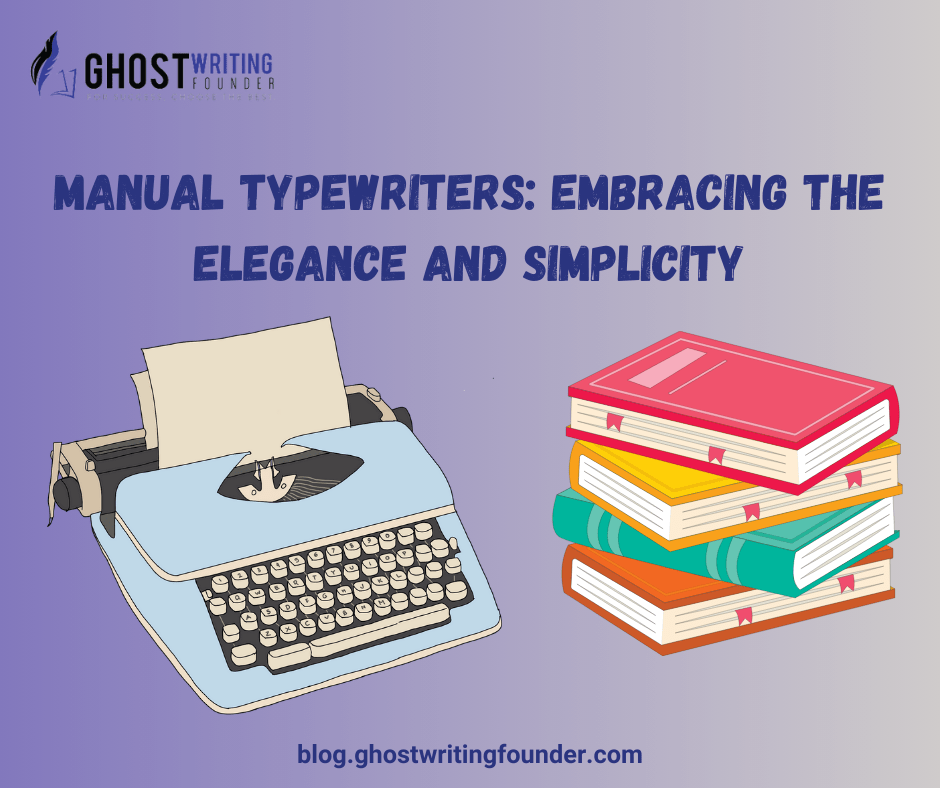
Writing
In a world filled with buzzing gadgets and glowing screens, have you ever wondered about the simpler times? A long time ago, people used manual typewriters to write and communicate. These magical machines were like today’s computers but with a special touch of elegance and simplicity, much like the Classic Books to Read at Least Once in Your Lifetime.
So, if you don’t know anything about them, this article will give you a perfect opportunity to learn about the elegance and simplicity of it. In this guide, the Ghostwriting Founder will tell you everything about manual typewriter and their appeal.
A Glimpse into the Past
Imagine a time before computers and smartphones, before even the internet! People needed a way to write things quickly and neatly. That’s where manual typewriters came in. Back in the day, they were the best thing you could have if you wanted a writing tool. They changed the way people communicated and worked. Imagine how exciting it must have been to hear the “click-clack” of the keys as words appeared on paper.

Manual typewriters were like a symphony of mechanics. When you pressed a key, it set off a series of movements that made a metal arm with a letter on it swing up and press ink onto the paper. The best part? You could feel the keys under your fingers, a tactile experience much like Exploring the Charm of Typewriter Keyboards. Each press was like a little victory; the typing rhythm created a soothing melody. It was a bit like dancing with your words on paper.
The Elegance of Simplicity
Have you ever looked closely at a manual typewriter? The chances are less, but worry not because we will tell you all about its elegance and simplicity.
They had something quite special within their simple design. Unlike the intricate gadgets we see today, manual typewriters were refreshingly straightforward. They featured a sturdy body, a basic keyboard, and a method to guide paper through. This simplicity holds a unique charm. When you engaged with a manual typewriter, your attention was solely on what mattered most: your words.
Manual typewriters shine with their elegant simplicity in a world where gadgets can sometimes overwhelm us with countless buttons and flashy lights.
Picture it: no complex menus, no notifications demanding your notice—just you, your thoughts, and the comforting clatter of keys.
These typewriters aren’t seeking to impress with bells and whistles; instead, they invite you to connect with your writing profoundly, similar to the approach of Writing for Different Age Groups. In their simplicity, they offer a tranquil escape from the noise of our modern devices. No need to worry about software updates or battery percentages. Manual typewriters remain steadfast in their purpose, ready to help you translate your ideas into words.
Navigating the Keyboard Layout
Keyboards on manual typewriters might look a little different from the ones you see on computers. They have a layout called QWERTY, named after the first six letters on the top row. This layout was designed to prevent typewriters from jamming when people typed too fast. While it might seem strange, many people got used to this layout and still use it today.
Typewriters in Modern Creativity
Guess what? People still use manual typewriters, even in our digital age. Artists and writers love the unique feel they bring to their work, often seeking that distinct touch as discussed in The Beauty of Book Aesthetics. Typewriters create letters with a bit of an uneven touch, adding a human touch to each piece. Some poets and writers use typewriters to create special, tangible pieces of writing that are unlike anything you can make on a computer.
How to Take Care of Your Manual Typewriter?
No matter how simple they seemed, manual typewriters required a lot of care, unlike regular keyboards. It needed attention to stay in tip-top shape. Here are some easy steps to keep your typewriter working smoothly and looking sharp.
Keep It Clean
Dust and dirt can sneak into your typewriter’s nooks and crannies. Give it a gentle wipe-down with a soft cloth to keep it tidy, much like the care you would give to the Cover Design & Typesetting of a book. Use a small brush to gently sweep away any particles between the keys.
Love the Lubrication
A little bit of oil can go a long way. A drop of sewing machine oil on the moving parts can help prevent rust and keep things moving smoothly. But remember, less is more – you don’t want to drown your typewriter.
Mind the Paper
The typebars – those metal arms with letters– can be delicate. Make sure the paper is positioned correctly to avoid any jams or snags. If a key gets stuck, never force it; gently release it instead.
Ribbon Check
If your typewriter uses a ribbon, keep an eye on it, and for more on the importance of such details, check out Organize Your Reading List with Book Tabs. Replace it when it gets worn to ensure your words come out clear and crisp.
Store It Right
When not typing up a storm, find a safe spot for your typewriter. Keep it away from direct sunlight, moisture, and extreme temperatures. A dust cover or a simple cloth can protect it from the elements.
Be Gentle
Typewriters might be tough, but they’re not invincible. Use a gentle touch when you type – there’s no need to pound the keys. And always return the carriage to its resting position when you’re done typing, ensuring the longevity of your machine, much like the enduring narratives crafted through Memoir Writing Services.
Regular Check-ups
Just like you visit the doctor, give your typewriter a regular check-up. Don’t hesitate to ask for professional help if you notice any issues. A little maintenance can prevent bigger problems down the line.
Main Attributes and Elaborate Information
| Aspect | Details | Related Section |
|---|---|---|
| Historical Significance | Used before computers and smartphones for quick, neat writing. | A Glimpse Into The Past |
| Mechanical Operation | Pressing a key triggers a metal arm to swing and press ink onto the paper. | A Glimpse Into The Past |
| Design and Simplicity | Sturdy body, basic keyboard, simple paper guide. | The Elegance Of Simplicity |
| Keyboard Layout | QWERTY layout designed to prevent jamming. | Navigating The Keyboard Layout |
| Modern Usage | Favored by artists and writers for its unique feel. | Typewriters In Modern Creativity |
| Maintenance Tips | Cleaning, lubrication, careful paper handling, ribbon check, gentle use. | How To Take Care Of Your Manual Typewriter? |
| Philosophical Appeal | Encourages focus and connection with writing, away from digital distractions. | Conclusion |
Conclusion
Manual typewriters offer a way to disconnect and slow down in a world filled with screens and constant notifications. They let you focus on what matters: the words you’re crafting. Typing on a manual typewriter can be like taking a deep breath and enjoying writing without distractions.
So, there you have it. Manual typewriters might seem like relics from the past, but they’re more than that. They’re elegant machines that invite us to step back, slow down, and connect with the art of writing. They remind us that simplicity can be beautiful in a world full of complexities.
If you ever get the chance, try typing on a manual typewriter. You might just be transported to a world where the “click-clack” of the keys creates a melody of memories and new stories.









Leave a Reply